2023
October – Unlocking the Secrets of Neuronal Function: A Universal Workflow
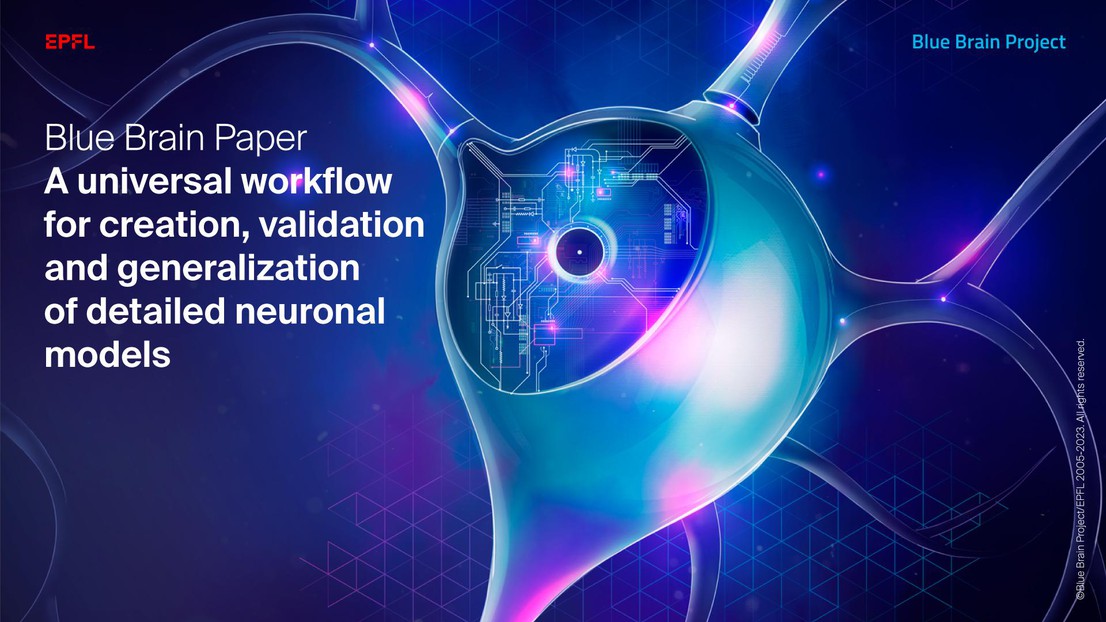
Detailed single neuron modeling has emerged as a powerful tool for exploring the intricacies of neuronal function. However, the diversity of neurons in the mammalian cortex, the outer layer of the brain responsible for higher cognitive functions, poses a significant challenge, as existing computational tools often focus on specific features of a single neuron type. In this new front cover paper published in Patterns, the EPFL Blue Brain Project introduces a groundbreaking new universal workflow that simplifies the creation, validation, and generalization of detailed neuronal models, offering researchers unprecedented insight into the world of neural science. Its usefulness and performance are demonstrated by the building of cell models for a significant portion of the rat cortex. The approach is built upon open-source tools, with all the steps freely available, and offers researchers a comprehensive solution for constructing neuronal models that can represent either a single biological cell or a predefined type of cells.
September – Empowering Neuroscientists: New Open Source Tools for Modeling

Concurrently with the release of a two-part preprint on the juvenile rat non-barrel Somatosensory Cortex (nbS1) covering both its anatomy and physiology as well as the release of the model itself, Blue Brain is sharing three complementary software packages. These were central in the simulation and analysis of the model which contains over 4 million structurally detailed neurons and more than 14 billion connections. Working with a model of that scale and level of detail is extremely complicated; Blue Brain therefore developed software tools for the simulation, validation, and analysis of the model.
ConnectomeUtilities is a powerful tool for researchers working with complex networks; it offers streamlined analysis and provides insights into network properties, especially in the context of biologically detailed models of neural circuits. BlueCelluLab is a versatile tool that allows scientists to conduct virtual experiments, helping them better understand the intricate behavior of brain cells. Meanwhile, Neurodamus enables the running of large-scale simulations on powerful computer clusters efficiently.
March – New Circuit Model Offers Insights into Brain Function

EPFL’s Blue Brain Project has developed a groundbreaking computational model of the thalamic microcircuit in the mouse brain, offering new insights into the role this region plays in brain function and dysfunction. The new model, published in Cell Reports, is the first to capture the complex shapes and biophysical properties of 14,000 neurons connected by 6 million synapses. It can be used to explore the structural and functional complexity of neural circuits. The model also replicates multiple independent network-level experimental findings across different brain states, and provides a novel unifying cellular and synaptic account of spontaneous and evoked activity in both wakefulness and sleep. The model is now accessible for researchers to use in their own studies via the Thalamoreticular Microcircuit Portal.
February – New release of Blue Brain Project Atlas sheds light on neuron types

After four years of research, EPFL’s Blue Brain Project shares an enriched version of their 3D digital cell atlas of the mouse brain which includes more neuron types. The new approach can be extended to any other cell type, and provides a resource to build tissue-level models of the mouse brain.
The new tools and methods used to refine the Cell Atlas and produce the BBCAv2, published in two companion papers in PLOS Computational Biology (Rodarie et al., Roussel et al.), were extended to map well identified types to inhibitory neuron subclasses, paving the way for more accurate in silico reconstructions of brain tissues. The data, algorithms, software, and results of the pipeline used to upgrade the Blue Brain Cell Atlas are all publicly available.
January – Blue Brain Nexus – brain scale data and knowledge management

Modern day science typically involves iterative cycles of data discovery, acquisition, preparation, analysis, model building and validation which often lead to knowledge discovery as well as knowledge sharing and dissemination. Given the ambitious goal of digitally building and simulating the mouse brain, the EPFL Blue Brain Project required a data and knowledge management system that could not only handle the enormous diversity and evolution of data at the scale of the whole brain, but also track the data’s provenance to ensure quality, reproducibility and accurate attribution throughout these iterative cycles. Accordingly, Blue Brain built and open sourced Blue Brain Nexus as a key technology for organizing brain tissue data and models and as a complementary approach to classical neuroinformatics tools. Blue Brain Nexus has now grown into an ecosystem of secured, domain-agnostic, scalable and interoperable tools with a growing community of adopters including large international organizations, across use cases that include neuroscience, psychiatry and open linked data.
2022
October – STEPS 4.0 towards large-scale biologically-relevant simulations

Simulating neurons down to the level of their biochemistry in order to understand their behavior and properties is a complex computational challenge. While small to the human eye, a neuron is a comparatively large object relative to its biochemical constituents. Yet, the overall behavior of a neuron depends on the specific composition and interactions at the molecular level that will control its electrical properties. It’s like aiming to fully describe a patch of forest down to the millimeter, recording the location and shape not only of each tree and each leaf, but of each grain of dirt. Even with high performance computing and ever increasing computing power, scientists still have to make uncomfortable compromises; phenomena that are random in nature are averaged out for ease of calculation, or only parts of a cell can be described with molecules and their interactions. Needing to choose between what is biologically relevant and what is able to be addressed, leads to significant loss of information and, often, relevance. In a paper published in Frontiers in Neuroinformatics, the Blue Brain collaboration with he Okinawa Institute of Science and Technology Graduate University, Japan (OIST) introduces a new generation of the project – STEPS 4.0.The paper describes how they pushed the boundaries of simulating biochemical diffusion-reaction models to the scale of entire neurons. The new solution dramatically reduces the computer memory needed while maintaining similar or better performance, increasing overall scalability.
September – Neuron Phenotype Ontology – classifying the brain’s building blocks

As the study of neuroscience accelerates ever faster and our understanding of the intricate workings of the brain deepens, the need to define a standardized approach to naming neuron types has become imperative. As the building blocks of the brain, neurons are studied intensely with vast amounts of data being generated and shared. With this comes several challenges as there is more and more data to describe different cell types. Furthermore, the literature contains many neuron names that are commonly used and accepted, even when it is unclear how such common usage types relate to the many proposed evidence-based types that are based on the results of new techniques. In addition, there is the significant question of comparing different data sets across labs. This all points to an urgent need for a standardized approach to naming neurons and for the organization of knowledge about their properties. In a paper recently published in Neuroinformatics, a collaboration of Scientists from the Swiss EPFL Blue Brain Project, University of California, San Diego, University of Toronto, Canada and the Krembil Centre for Neuroinformatics, Canada, propose an interoperable knowledge representation – Neuron Phenotype Ontology (NPO). The NPO is an open source standardized and automatable approach for naming cell types and normalizing their constituent phenotypes using identifiers from community ontologies as a common language. It is designed to enable scientists to discover which cell types (or potential cell types) share similar properties and to help scientists understand when the cell types they observe are the same or similar to other cell types described in the literature or from other laboratories. Moreover, it provides a framework for systematically organizing knowledge about cellular properties and enables interoperability with existing neuron naming schemes.
July – A secret language of cells? New cell computations uncovered

Throughout evolution, individual cells have been making successful decisions on their own, even while forming parts of vast networks, such as neurons and glia in the human brain. Now scientists from the EPFL Blue Brain Project and King Abdullah University of Science and Technology (KAUST) have published a new theory in the Journal of Theoretical Biology describing a secret language that cells may use for internal dialog about the external world. Using a computational model, they hypothesize that metabolic pathways, which are primarily a means of extracting energy and building block molecules from glucose and other substrates to feed the brain, might also be capable of coding details about neuromodulators that stimulate increases in energy consumption. If true, this would open the door to a nearly infinite number of possibilities for information processing in nervous systems as component cells could compute in previously unexplored ways. Such a mechanism would also help explain the remarkable energy efficiency of brains.
July – Sustainable, portable and high performing – updated NEURON simulator

In recent years, simulation has firmly become the third pillar, alongside theory and experimentation, for studying the brain. The computational models of brain components, brain tissue or even whole brains provide new ways to integrate anatomical and physiological data and allow insights into causal mechanisms crossing scales and linking structure to function. Over the past four decades, the NEURON simulator has been developed and continuously extended to enable neuroscientists to model the electrical activity of neuronal networks. Today, it is one of the most widely used simulation environments for biologically detailed neurosimulations. As these models gain in size, complexity and detail, so do their computational requirements. In addition, these simulations are typically run on computer systems ranging from laptops to supercomputers and in the cloud, and must do so efficiently. This means that such complex software must be easily maintainable, to continuously provide these improvements crucial to the computational scientist’s work.
In a paper recently published in Frontiers in Neuroinformatics, the EPFL Blue Brain Project has collaborated with Yale University and the Department Physiology and Pharmacology, SUNY Downstate, New York to substantially modernize NEURON. The result is better software sustainability, improved software and hardware portability and increased simulator efficiency.
June – Does one simple rule underlie learning in the brain?

What underlies learning in the brain might be actually simpler than previously thought despite the brain being one of the most complex objects in the known universe. A collaboration of Scientists led by the EPFL Blue Brain Project has achieved a major advance in accurately simulating the synaptic changes thought to implement learning in the neocortex, opening the door to greater understanding of learning in the brain.
In a paper published in Nature Communications, a group of scientists from the EPFL Blue Brain Project, together with collaborators from Université de Montréal, Université de Paris, Hebrew University of Jerusalem, Instituto Cajal, and Harvard Medical School, introduce to the neuroscience community a model of synaptic plasticity for Pyramidal Cells (PCs) in the neocortex based on data-constrained postsynaptic calcium dynamics. By comparing their results to the available experimental data, they show that their synaptic plasticity model can capture the varied plasticity dynamics of the diverse PCs making up the neocortical microcircuit. They achieve this with only one unified model parameter set, indicating the plasticity rules of the neocortex could be shared across pyramidal cell-types.
April – Blue Brain Builds Neurons with Mathematics
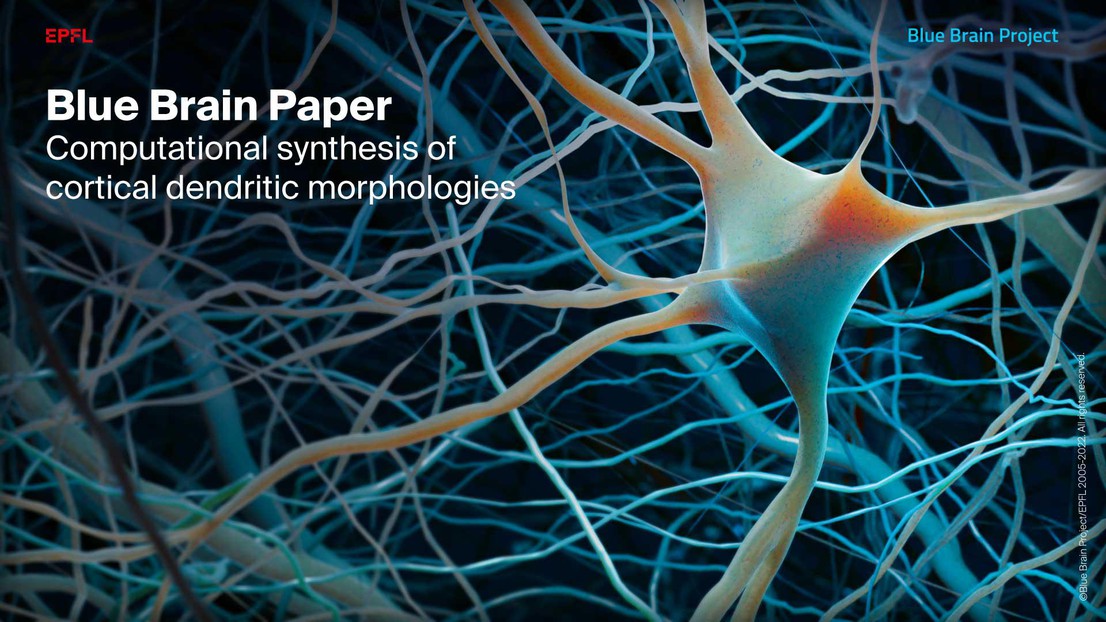
EPFL’s Blue Brain Project has found a way to use only mathematics to automatically draw neurons in 3D, meaning we are getting closer to being able to build digital twins of brains.
Using algebraic topology, a field of Math, a Blue Brain team created an algorithm that requires only a few examples to generate large numbers of unique cells. Using this algorithm – the Topological Neuronal Synthesis (TNS), they can efficiently synthesize millions of unique neuronal morphologies.
2021
November – The First Digital Reconstruction of the Neuro-Glia-Vascular Architecture
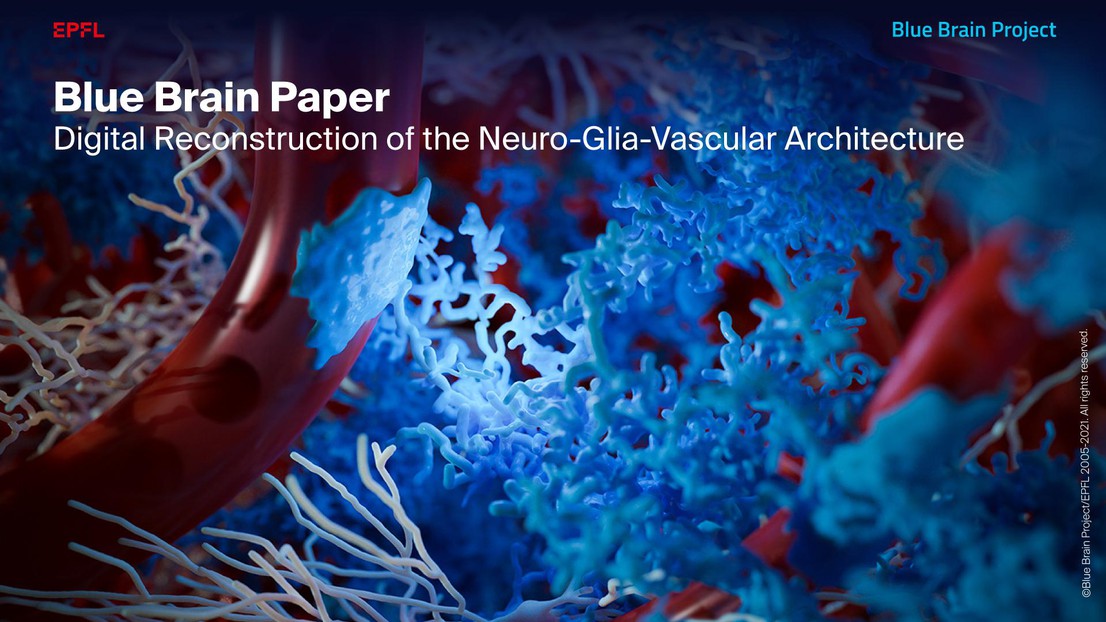
The study, published in Cerebral Cortex, represents a major milestone for the EPFL Blue Brain Project because they can now reconstruct the architecture of non-neuronal entities such as blood vessels and the supporting cells called glia. This means it is possible to capture the way that neurons, glia and the blood supply interact. These reconstructions of the brain tissue provide a sub-micron precise framework needed to simulate the molecular interactions relevant to understanding how neurons are supported and nurtured. They can also be used to investigate how drugs interact and explore how neurodegenerative diseases arise. Blue Brain has made all the experimental data, models and tools used to reconstruct brain tissue at this resolution, open source in the Blue Brain NGV web portal.
October – A Molecular Atlas for the Brain
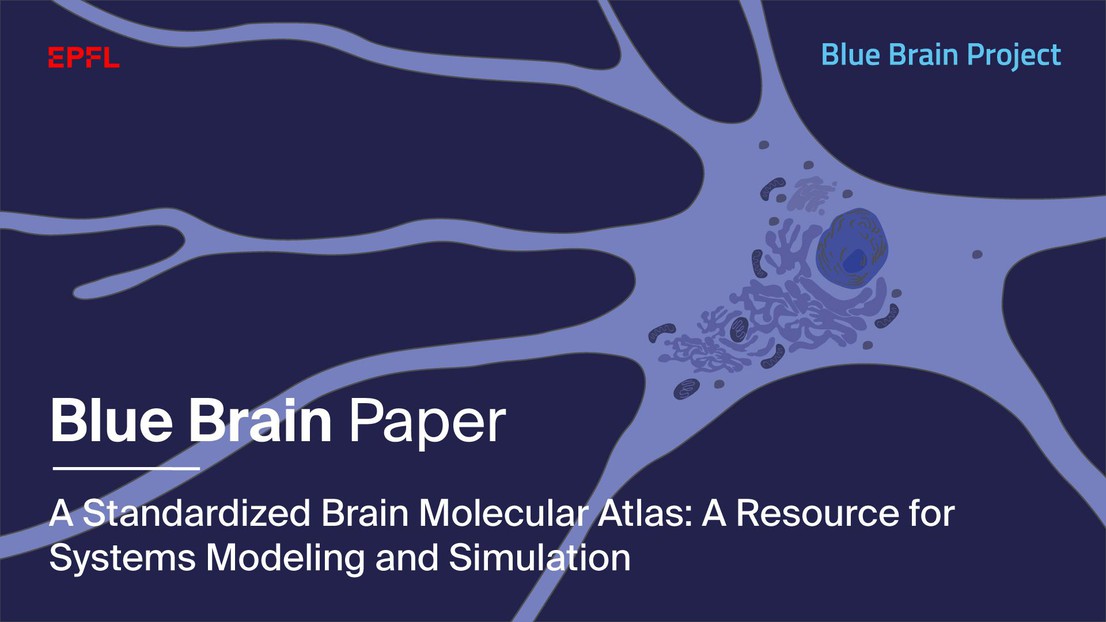
Blue Brain open sources a simulation-ready database to accelerate molecular and systems biology.
Blue Brain scientists performed an extensive meta-analysis to integrate protein and metabolite quantitative data from publicly available resources and created this simulation-ready database to support more standardized and comparable molecular and systems biology studies.
July – Blue Brain Study – A machine reveals how glucose helps the SARS-CoV-2 virus
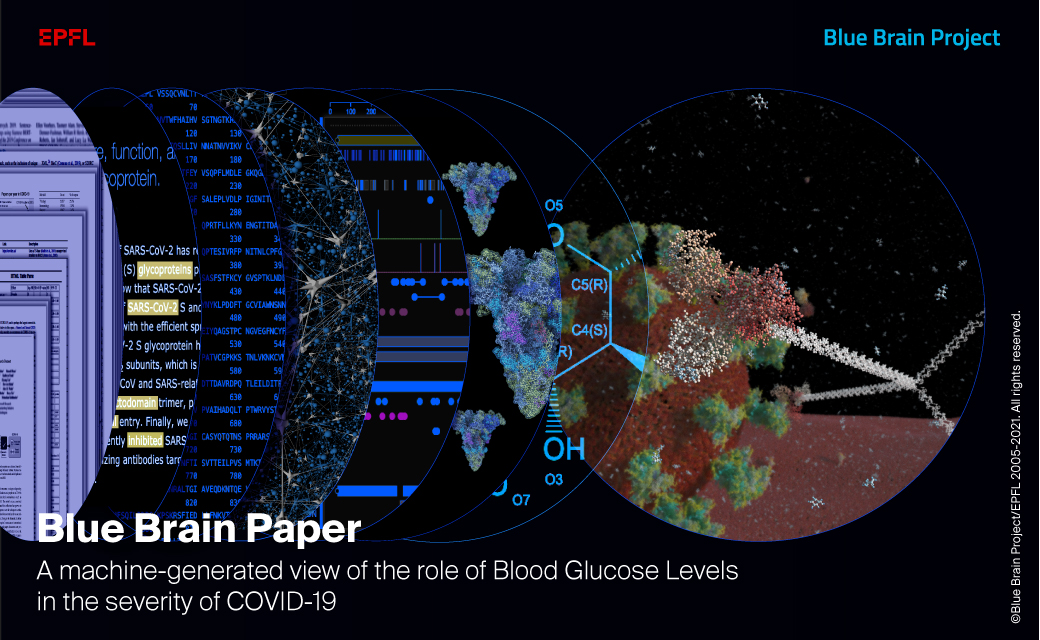
EPFL’s Blue Brain Project deployed its powerful brain simulation technology and expertise in cellular and molecular biology to try and answer this question. A group in the Blue Brain assembled an AI tool that could read hundreds of thousands of scientific papers, extract the knowledge and assemble the answer – A machine-generated view of the role of Blood Glucose Levels in the severity of COVID-19 was published today by Frontiers in Public Health.
January – COVID-19 Crisis – A technology providing unconventional supply relief

2020
October – A step closer to mapping the rodent brain

July – Blue Brain co-develops COVID-19 Diagnostic Implementation Simulator
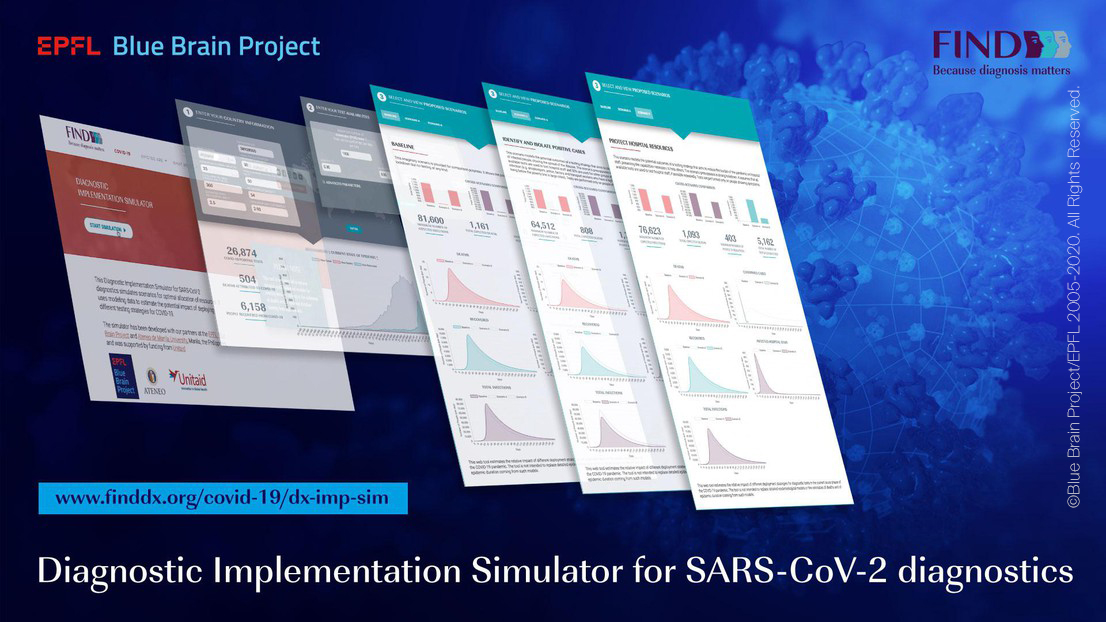
July – Blue Brain Nexus Forge: Building and using Knowledge Graphs made easy

May – EPFL and ETH Zurich deliver Academic Resources platform for COVID-19
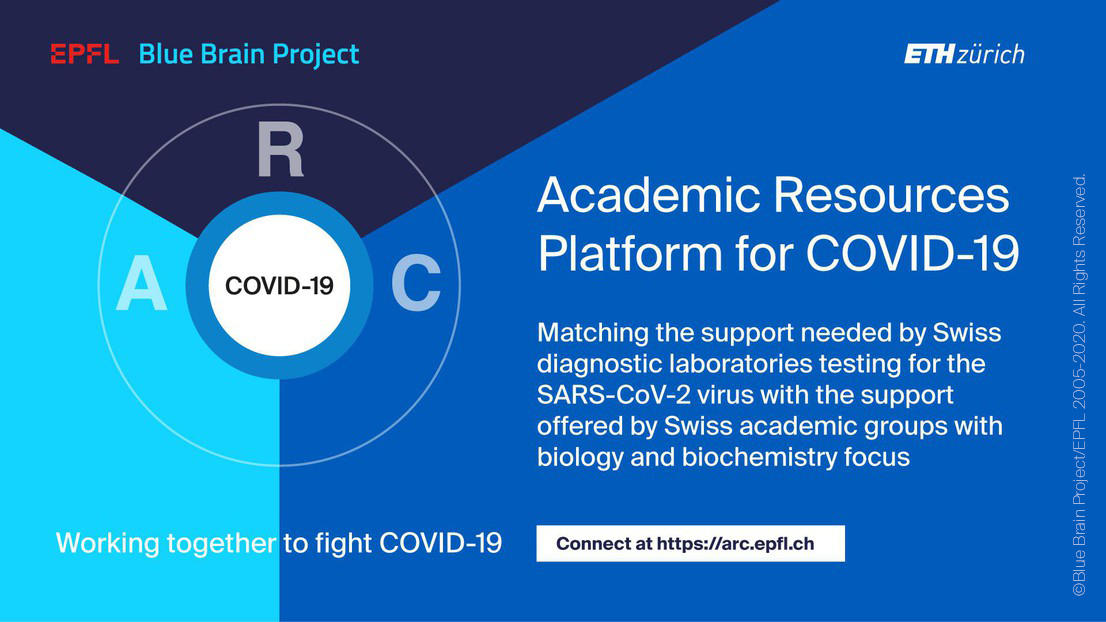
February – Blue Brain enable next generation brain simulations with performance modeling
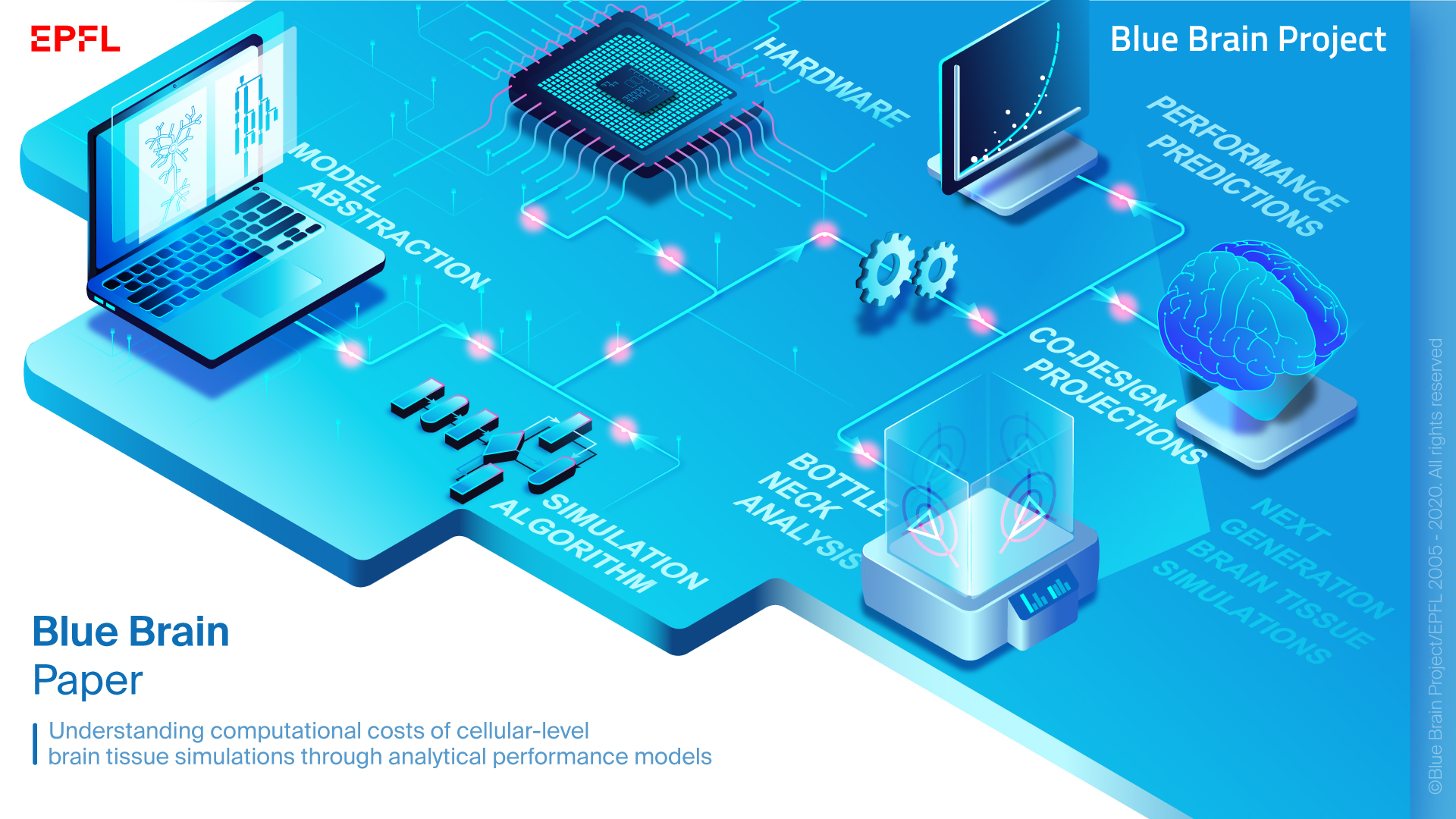
January – Neuron_Reduce – a brand new tool to simplify complex neuron models.
Blue Brain collaboration with the Hebrew University of Jerusalem.

2019
August – Blue Brain finds the secret to how neurons in the mouse neocortex form billions of synaptic connections

August – Brain finds order amidst chaos

August – Blue Brain ion channel study beckons first whole-brain simulation

July – Blue Brain builds the first next-generation models of thalamocortical neurons

May – Second NM2 Conference Concluded

March – Blue Brain solves a century-old neuroscience problem
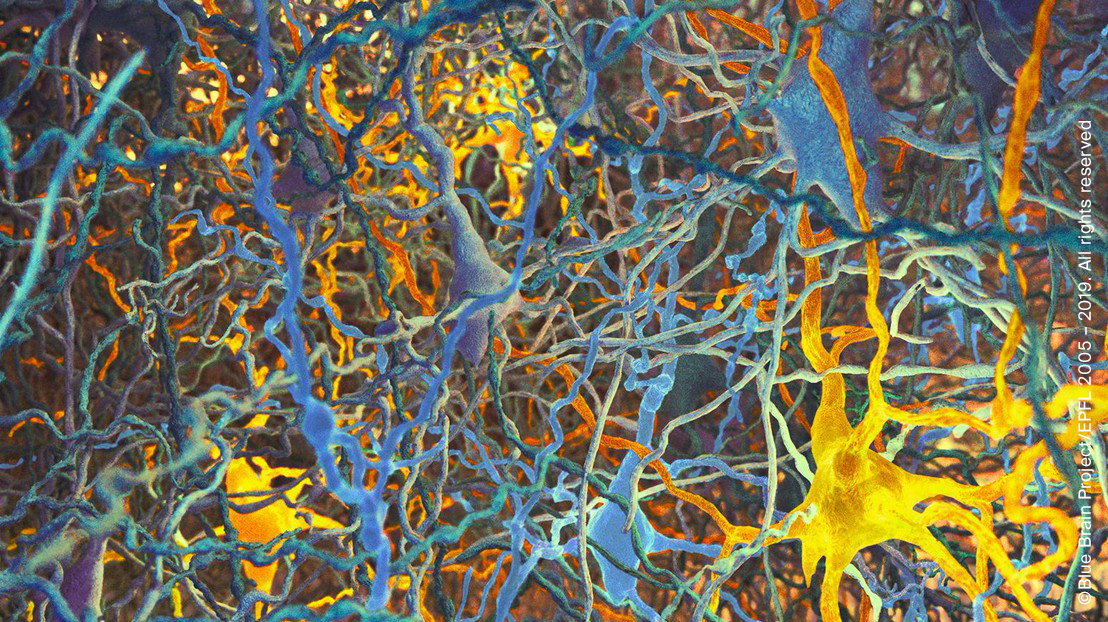
2018
November – Blue Brain Project releases first-ever digital 3D brain cell atlas

The first digital 3D atlas of every cell in the mouse brain provides neuroscientists with previously unavailable information on major cell types, numbers and positions in all 737 brain regions – which will potentially accelerate progress in brain science massively.
Autumn

In the Autumn of 2018, Blue Brain attended and hosted several outreach events. These included the Cité des Métiers in Geneva where Blue Brain scientists and engineers met STEM students from the Geneva region. During ‘Planète Santé Live’ also in Geneva, thousands visited the Blue Brain stand to learn more about the Project.
At the Campus Biotech, the Project welcomed a delegation of primary and secondary school heads and Neurology students from Slovenia and The Life Lab Foundation who brought 56 students with a strong interest in Science from India.


August – The Blue Brain Portal
– a knowledge space for simulation neuroscience is launched as a public resource

July – Blue Brain project deploys HPE supercomputer for digital reconstruction and simulations of the mammalian brain to advance the understanding of the brain

Frontiers hosted its second Data Services Workshop in Brussels on April 24 with this year’s workshop focusing on the application of open research data to support sustainable health initiatives. Drawing lessons from recent successes in the use of big data and artificial intelligence in data-intensive health research, it aimed to discuss policy challenges and actions necessary in Europe to unleash the full potential of open research data in health for the benefit of society.
As part of the ‘cutting-edge technologies and services for data-intensive health research’ session, Samuel presented the Blue Brain Nexus to over 130 attendees from all over Europe (including policymakers, researchers, academics, patient advocates, tech & pharma companies, universities, funders and libraries).Credit – Samuel Kerrien presenting in Brussels ©️Simon Pugh Photography
January – Blue Brain Nexus: an open-source knowledge graph for data-driven science

2017
December – Simulating Biophysical Principles of Functional Synaptic Plasticity in the Neocortex – Blue Brain’s INCITE grant renewed for 2018
In December 2017, Blue Brain’s INCITE grant is renewed for 2018 to provide a further 160 million core hours at the Argonne National Laboratory. INCITE supports computationally intensive, large-scale research projects with large amounts of dedicated time on supercomputers at DOE’s Leadership Computing Facilities. In 2017, INCITE awarded the Blue Brain with 100 million core hours to simulate biophysical synaptic plasticity in reconstructions of the neocortical microcircuit to discover their synergistic functional principles.
July – Blue Brain Project launches three-day conference to kick-start neuromodulation research – NM2

Leading experts from around the world presented and took part in panel discussions across the three days. Additionally, the NM2 Conference provided a unique platform for students and junior researchers to interact with leaders in the field to collectively take part in shaping the future course of neuromodulatory research.
June – Blue Brain Team Discovers a Multi-Dimensional Universe in Brain Networks

This research, published in Frontiers in Computational Neuroscience, has significant implications for our understanding of the brain.
To date the paper has been viewed over 300,000 times.
Two more important papers were also published in June. In a paper published in Cerebral Cortex , we investigated the role of morphological diversity within and across neuronal types on emergent connectivity in a model of neocortical microcircuitry. Our investigation found that the average overlap between the dendritic and axonal arbors of different types of neurons determines neuron-type specific patterns of distance-dependent connectivity, severely constraining the space of possible connectomes. Reimann, M.W., Horlemann, A.-L., Ramaswamy, S., Muller, E.B., and Markram, H. (2017). Morphological Diversity Strongly Constrains Synaptic Connectivity and Plasticity. Cereb.Cortex 27, 4570–4585. DOI: 10.1093/cercor/bhx150
In the second paper published in Nature Neuroscience, the group of Idan Segev of the Hebrew University of Jerusalem in collaboration with the Cells & Circuits team in the Simulation Neuroscience Division of the Blue Brain, and Tel Aviv University identified a rich cell-type-specific network topology in neocortical microcircuitry. The systematic approach presented in the paper has enabled interpretation of microconnectomics ‘big data’, and provided several experimentally testable predictions. Gal, E., London, M., Globerson, A., Ramaswamy, S., Reimann, M.W., Muller, E., Markram, H., and Segev, I. (2017). Rich cell-type-specific network topology in neocortical microcircuitry. Nat. Neurosci. 20, 1004–1013.
DOI: 10.1038/nn.4576
2016
November – The Project Management Office function is launched under the supervision of Adriana Salvatore, Director of Operations

June – Blue Brain releases Open Source Software providing model parameter optimization for neuroscientists – Blue Brain Python Optimization Library (BluePyOpt)

The Blue Brain Project releases the Blue Brain Python Optimization Library (BluePyOpt) – an extensible open source framework for data-driven model parameter optimization that wraps and standardizes several existing open-source tools. The library includes methods for setting up small- and large-scale optimizations on a broad range of compute platforms – from laptops to large cloud-based compute infrastructures.
Van Geit, W., Gevaert, M., Chindemi, G., Rössert, C., Courcol, J.-D., Muller, E.B., Schürmann, F., Segev, I., and Markram, H. (2016). BluePyOpt: Leveraging Open Source Software and Cloud Infrastructure to Optimise Model Parameters in Neuroscience. Front Neuroinform 10.
DOI: 10.3389/fninf.2016.00017March – The Allen Institute for Brain Science collaborates with the Blue Brain Project to model neurons from mouse visual cortex

On March 3, the US-based Allen Institute of Brain Science released a set of 40 computer models of neurons from the mouse visual cortex, created using tools developed by the Blue Brain Project. Using Blue Brain technology, the researchers were able to reproduce the physiology and electrical activity of the neurons with an extremely high level of detail. For further details click here.
March – Blue Brain wins major award of supercomputing time from DOE
A Blue Brain team, led by Eilif Muller, won a major award of supercomputing time, from the US Department of Energy’s prestigious Incite Leadership Computing Program. The award gives the team an unprecedented opportunity to simulate synaptic plasticity—the process through which brain activity shapes synaptic connections. The study – which will build on Blue Brain’s recently published reconstruction of neural microcircuitry – focused on the impact of plasticity on the detailed organization and functioning of neural networks. The results provided insights, not just to neuroscientists but also to technologists, seeking to implement brain-like learning mechanisms in software and hardware.
2015
December – The Neocortical Microcircuit collaboration portal

October – Algorithm to predict connectivity in neural microcircuits
Blue Brain published a paper describing a mathematical algorithm that predicts the location of nearly 40 million synapses formed between the neurons in a small block of brain tissue about 100’000 times larger than has ever been analyzed with electron microscopy.
The algorithm uses millions of times less experimental data than would normally be needed using purely experimental methods. The algorithm was developed as part of the Blue Brain Project’s mission to digitally reconstruct the biological detail of the mouse brain and is a companion paper to the team’s paper on the Reconstruction and Simulation of Neocortical Microcircuitry.
Reimann, E.Muller, S.Ramaswamy, H.Markram: An Algorithm to Predict the Connectome of Neural Microcircuits. 2015. Frontiers in Neural Circuits 9 2015, 28.
October – Major Milestone achieved – Digital reconstruction of neocortical microcircuitry

Blue Brain reaches a major milestone with the publication of a first draft of the digital reconstruction of neocortical microcircuitry (Markram et al, 2015). The study confirmed the feasibility of building and simulating a digital copy of a part of the brain and demonstrated that multidisciplinary Big Science in the field of neuroscience yields favorable results (82 scientists contributed to the study).
The paper, which appeared in the journal Cell, represents the most complete description of any neural microcircuit to date. It provides a complete digital map of all the cells and synapses in a block of neural tissue and describes simulation experiments replicating a range of previous in vivo experiments. In other words, our digital copy of a part of the brain behaves like a real part of the brain.
Most significantly, this study advances the case for simulation as a useful new method in neuroscience. It proves that we understand the basic properties of the components and interconnections of the brain well enough to be able to reconstruct and simulate certain physiological functions.
Markram et al., Reconstruction and Simulation of Neocortical Microcircuitry. Cell 163, 2015, 456-492.
DOI: 10.1016/j.cell.2015.09.029
August – Blue Brain Team Selected to Participate in Argonne Early Science Programme
The Blue Brain Project’s High Performance Computing Team (HPC) has been selected by the Argonne Leadership Computing Facility (ALCF) to participate in the two-year Theta Early Science Program.
This program will target the porting and optimization at large scale of our CoreNeuron scientific application on ALCF next leadership-class supercomputer prototype, Theta.
This opportunity will allow the HPC team developers to collaborate with Intel, Cray and ALCF HPC specialists to drive the development of CoreNeuron to support four challenging scientific use cases: (a) The analysis of the electrical activity of the mouse brain Somatosensory Cortex, (b) The study of Synaptic Plasticity phenomenon in a mouse brain, (c) The building and simulations of a full mouse brain model and (d) The study of the activity and plasticity of a mouse brain model when embedded into a simulated body interacting within its environment.
Read more – https://www.alcf.anl.gov/news/alcf-selects-projects-theta-early-science-program
April – Launch of Sino-Swiss Laboratory for Data Intensive Neuroscience
EPFL and the Chinese Academy of Sciences will collaborate on Neuroinformatics platforms, Data and Knowledge integration, algorithms for Brain Reconstruction and Brain Atlas platforms.
Read more – http://english.ia.cas.cn/ne/news/201504/t20150401_145949.html
2014
In June, the BBP replaces its previous supercomputer (the BlueGene/P) with a BlueGene/Q machine (Blue Brain 4) hosted at the Swiss National Computing Centre (CSCS) in Lugano. The new machine offers higher performance and expanded memory.
In the same month, Blue Brain, IBM Research and ETH Zürich announce a collaboration to develop a new hybrid memory strategy for supercomputers, matching the heavy memory requirements for reconstructions of large volumes of neural tissue (brain regions, whole brains).
The Blue Brain Project completes validated digital reconstructions of neural microcircuitry in the brain of young rats. Work begins on a major paper, presenting the reconstruction, and on online resources, making the results available to the broader community.
2013
The Blue Brain Project is officially granted the status of a Swiss National Research Infrastructure, funded by the ETH Board.
Neural simulations hint at the origin of brain waves

For almost a century, scientists have been studying brain waves to learn about mental health and the way we think. Yet the way billions of interconnected neurons work together to produce brain waves remains unknown. Scientists from Blue Brain and the Allen Institute for Brain Science showed in a paper published in journal Neuron how a complex computer model is providing a new tool to solve the mystery.
M.W. Reimann, C.A.Anastassiou, R.Perin, S.L.Hill, H. Markram, C. Koch: A biophysically detailed model of neocortical local field potentials predicts the critical role of active membrane currents. Neuron, 79(2), 375-390, 2013. DOI: 0.1016/j.neuron.2013.05.023
Two important Blue Brain publications describe the use of Blue Brain Project models to identify and characterize “neuronal clusters” in neural microcircuits, and to predict local field potentials.
R.Perin, M.Telefont, H.Markram: Computing the size and number of neuronal clusters in local circuits, Front Neuroanat. 2013;7:1. Epub 2013 Feb 19. https://doi.org/10.3389/fnana.2013.00001
S.Druckmann, S.Hill, F.Schürmann, H.Markram, I.Segev: A Hierarchical Structure of Cortical Interneuron Electrical Diversity Revealed by Automated Statistical Analysis, Cerebral Cortex, (2012),
DOI: 10.1093/cercor/bhs290
2012
In a landmark paper published in PNAS, the EPFL’s Blue Brain Project (BBP) has identified key principles that determine synapse-scale connectivity by virtually reconstructing a cortical microcircuit and comparing it to a mammalian sample. These principles now make it possible to predict the locations of synapses in the neocortex.
S.L.Hill, Y.Wang, I.Riachi, F.Schürmann, H.Markram: Statistical connectivity provides a sufficient foundation for specific functional connectivity in neocortical neural microcircuits. Proceedings of the National Academy of Sciences, 109(42). https://doi.org/10.1073/pnas.1202128109
Watch the videoAt the Neuroscience 2012 conference in New Orleans, the Blue Brain Project presented more than 20 posters, describing a first reconstruction of the rat cortical column.
This enormous poster series displayed the building of the cortical column model from the bottom up – including the reconstruction of the neuron types to attain their morphologies (called the M-types), the establishment of their electrical patterns (called the E-types), the combination of M- and E- types to get the ME-types, the placement of neurons, the connectivity and interaction between neurons and how all of this goes in to produce the unifying Blue Brain cortical column model.
Click here to watch the series of short videos – The Unifying Cortical Column Model Poster Series.
2011
The Blue Brain Project hires new engineers and scientists. In November, the enlarged team moves to new office space in the EPFL Innovation Park. The Blue Brain Project publishes several high impact papers describing new methods to generate cell models and in silico studies of virtual brain tissue.
2010
2009
“In silico” experimentation is in full swing, testing the behavior of Blue Brain Project models against results from other research groups. The results provide new insights into the principles underlying the construction of neocortical microcircuitry.
2008
2007
In January, Prof. Henry Markram presents the Blue Brain Project to the Davos forum.
In October, Blue Brain paper – A Novel Multiple Objective Optimization Framework for Constraining Conductance-Based Neuron Models by Experimental Data was published in Frontiers in Neuroscience, Vol. 1, Issue 1, 2007.
DOI: 10.3389/neuro.01.1.1.001.2007
November 26, marks the end of the first phase of the Project, which announces the completion of an initial model of the rat cortical column.
2006
In February, the project takes shape. An article in Nature Reviews Neuroscience by Prof. Henry Markram describes the project’s goals and methods.
During the summer, the BBP team generates its first model of a cortical column, using a simplified neuron model.
2005
In June, the EPFL and IBM sign an agreement to launch the Blue Brain Project (BBP). The agreement provides for the installation of a BlueGene supercomputer on the EPFL campus.

